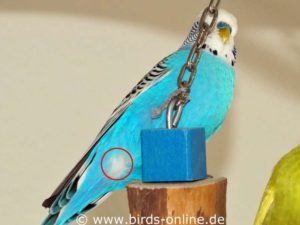- >>
- Birds Online – English
- >>
- Health and diseases
- >>
- General health topics
- >>
- Bird anatomy
- >>
- Cloaca or vent
Cloaca or vent

Unlike us humans, budgies have only one excretory opening. This posterior orifice is part of a section of the rectum that is called the cloaca. Only a small part of it is visible (the opening itself). Through this opening, the remains of the digested food (excrements) and urine are excreted from the bird’s body. Furthermore, this orifice is important for the reproduction of birds. Most male birds have no penis. Instead, they secrete their sperm via the cloaca. In females, the semen enters the body through the cloaca. The female birds also press the eggs outwards through the posterior orifice.
The inner part of the cloaca as well as the posterior opening are highly elastic. To prevent it from being permanently open, the posterior body orifice is surrounded by a strong, ring-shaped sphincter (a muscle). Inside the body, the cloaca is coated with a sensitive mucous membrane. Under certain circumstances, this mucosa can slip outwards. Vets call this condition a cloacal prolapse or prolapsed vent. Mostly female birds are affected, but males can also suffer a cloacal prolapse in certain situations. Especially the males of some cockatoo species tend to develop a cloacal prolapse.

Around the cloaca, budgies have soft, delicate, and white or gray feathers. These are the down feathers. In general, the plumage around the vent is clean with no excrements or urine sticking to it. If the plumage around the cloaca is dirty from excrements, the bird might be suffering from a disease such as diarrhea or kidney inflammation. Therefore, this symptom should always be taken seriously. Pet owners should take an affected bird to an avian veterinarian as soon as possible.
